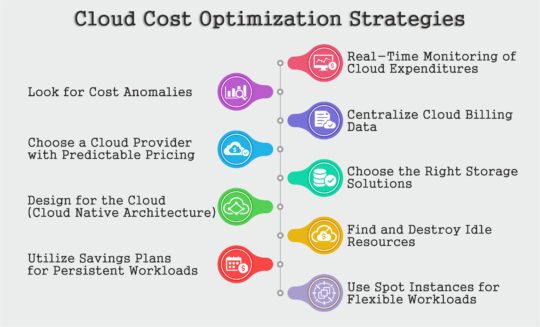The cloud market is growing at the fastest pace. From SMBs to large-scale enterprises, they rely on the power of cloud infrastructure. With cloud, you enjoy on-demand computing resources, pay for what you use, flexibility, scalability and more features required for your business success. But what if these cloud platforms become challenging for you. Ask how?
Yes, businesses often take full benefit of cloud’s scalability and flexibility. They soon become overcrowded with underutilized or unused resources, adding needless complexity and climbing up IT budgets. Concerned with the same?
Cloud cost optimization is the savior! By utilizing effective strategies and practices in place, businesses can cut down their cloud spending. This guide will walk you through the best practices and ways you can achieve optimal cloud cost management.
Let’s get started!
Understanding Cloud Cost Optimization
Cloud cost optimization is basically an effective approach to reducing cloud costs with the right tools, techniques and best practices. You can run applications in the cloud environment with ease and get a higher business value.
To gain greater insights into your cloud environment is the main aim of cloud cost optimization. It also maintains a balance between cost, performance, security and availability while ensuring all the resources are utilized efficiently.
As the cloud workload requirements, cloud pricing, and cloud service options are always changing, cloud cost optimization is a dynamic process. Thus, the right metrics, analytics, and automated technologies are required for cloud cost optimization.
Why Cloud Cost Optimization is Important?
Cloud resources are costly, meaning, organizations invest in cloud a lot. In short, the expenditure of IT companies goes toward the cloud, increasing the IT budgets. Thus, optimizing cloud is an ideal method of releasing funds that the company may use to reinvest in other areas, such as installing AI and other new technologies. If you want to unleash full business benefits using the power of clouds, optimization is essential.
Top Cloud Cost Optimization Strategies
Cloud cost optimization demands a proactive and strategic effort. The following are the top strategies to enable your organization to derive maximum cloud value while avoiding wasteful costs:
1. Real-Time Monitoring of Cloud Expenditures
You can't optimize something you're not measuring. Keep an eye on your cloud costs on a regular basis, not only when the bill comes out once a month, but all the time. All major cloud vendors have billing consoles that give you real-time or near-real-time visibility into your actual and projected costs. Keeping an eye on your costs allows you to catch inefficiencies early on and avoid bill shock.
2. Look for Cost Anomalies
As you track costs, look out for unusual spikes or deviations from normal usage trends. Unusual expenditures can reflect inefficiencies like idle resources, misconfigurations, or unauthorized deployments (so-called shadow IT). Catching anomalies early lets you resolve inefficiencies before they make a large dent in your budget.
3. Centralize Cloud Billing Data
If your organization uses multiple cloud providers, centralizing billing data into a single dashboard provides a comprehensive view of your cloud expenses. This approach eliminates the need to log into multiple portals and simplifies cost tracking and reporting across your cloud environments.
4. Choose a Cloud Provider with Predictable Pricing
Cloud providers with complicated and volatile pricing models can complicate budgeting. Choose providers that provide transparent, clear, and simple pricing models. Predictable pricing allows your teams to make informed decisions regarding resource utilization and provides tighter cost management.
5. Choose the Right Storage Solutions
Not all data requires the same storage type. Selecting the appropriate storage class can significantly affect your costs:
-
- Block Storage is ideal for high-performance, transactional data needs but typically comes at a higher cost.
- Object Storage is much more cost-effective for large volumes of unstructured or infrequently accessed data, such as backups or archives.
Align your storage options with your data access patterns and performance needs to optimize costs without sacrificing performance.
6. Design for the Cloud (Cloud Native Architecture)
Migrating and moving traditional applications to the cloud can appear simpler, but it creates inefficiencies and increased expenses since those programs are not designed to take advantage of cloud-native features such as autoscaling and managed services. Alternatively, cloud-native application design or refactoring allows for the best use of resources, cost-effectiveness, and simplicity of maintenance despite the initial investment in retraining staff and redevelopment.
7. Find and Destroy Idle Resources
Overprovisioning and idle resources are two of the biggest offenders of wasted cloud spend. Developers tend to spin up compute instances, load balancers, and storage volumes and then simply forget to turn them off after use. Use cloud management tools from your vendor or established third-party providers to monitor usage, identify underused or idle assets, and retire them preemptively. For example, Brazilian retail company Tok&Stok used Oracle's monitoring solutions to scale resources automatically, reducing idle server costs significantly.
8. Utilize Savings Plans for Persistent Workloads
Savings Plans, such as AWS ones, provide substantial discounts—up to 70%—over regular on-demand prices in return for one- or three-year usage commitments. These are flexible across instance type and region and are very well-suited for repetitive, steady-state loads.
9. Use Spot Instances for Flexible Workloads
Spot Instances permit you to bid on spare cloud capacity at significantly reduced prices. Although these instances are economical, they do expose you to the possibility of interruption should capacity elsewhere be required. Spot Instances are well suited for batch processing, testing, data analysis, and other flexible workloads that can absorb intermittent interruptions.
Wrapping it Up
Through the adoption of these strategies, organizations are not only able to manage their cloud costs but also realize improved operational efficiency and scalability. Cloud cost optimization is not a static activity, it is an ongoing practice of continuous monitoring, proactive management, and strategic resource planning.
To stay updated with such trending blogs, visit here now.
Recommended For You:
Best Cloud Cost Management Tools: You Should Be Aware Of
Cost Function in Machine Learning – Meaning, Types, and Importance





